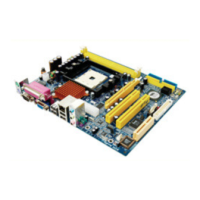
Do you have a question about the Mercury KVM800M Series and is the answer not in the manual?
| Brand | Mercury |
|---|---|
| Model | KVM800M Series |
| Category | Motherboard |
| Language | English |
Overview of the motherboard's main capabilities and specifications.
Information on the VIA K8M800 Northbridge and VT8237 Southbridge.
Details on Socket-754 processors (AMD Athlon 64/Sempron).
Information on DDR SDRAM compatibility and capacity.
Types of expansion slots like AGP, CNR, and PCI.
Details on IDE and Serial ATA connectors.
Information on AC'97 Codec and optional Fast Ethernet LAN.
Specifications and capabilities of the USB 2.0 ports.
Introduction to the AMI BIOS and its configurable features.
Visual guide to locate key components and connectors on the motherboard.
Explanation of rear panel I/O ports and their usage.
Step-by-step guide for safely installing the CPU.
Instructions for installing DDR SDRAM modules into DIMM sockets.
Configuration of jumpers, including how to clear CMOS.
Guidance on physically mounting the motherboard in a computer case.
Connecting the ATX power supply to the motherboard.
How to connect front panel audio, USB, and speaker headers.
Connecting floppy, IDE, and Serial ATA drives.
Procedure for installing cards into AGP, CNR, and PCI slots.
Understanding the purpose and importance of BIOS settings.
How to enter and use the BIOS setup interface.
Configuring system date, time, and IDE device parameters.
Fine-tuning system performance and boot behavior.
Enabling/disabling onboard devices like Floppy, COM, Parallel, IDE, Audio, LAN, USB.
Configuring ACPI and APM power saving modes.
Managing PCI bus resources and Plug and Play devices.
Setting up supervisor and user passwords for system security.
Configuring CPU settings, frequency, and voltage.
Viewing system temperatures, fan speeds, and voltages.
Options to restore optimal or default BIOS settings.
Overview of the drivers and utilities included on the CD.
Guide to installing drivers and utilities from the support CD.
Steps for auto-installing software on Windows 2000/XP.
Procedure for installing software manually or on Windows NT.
Process for installing specific bundled applications.
